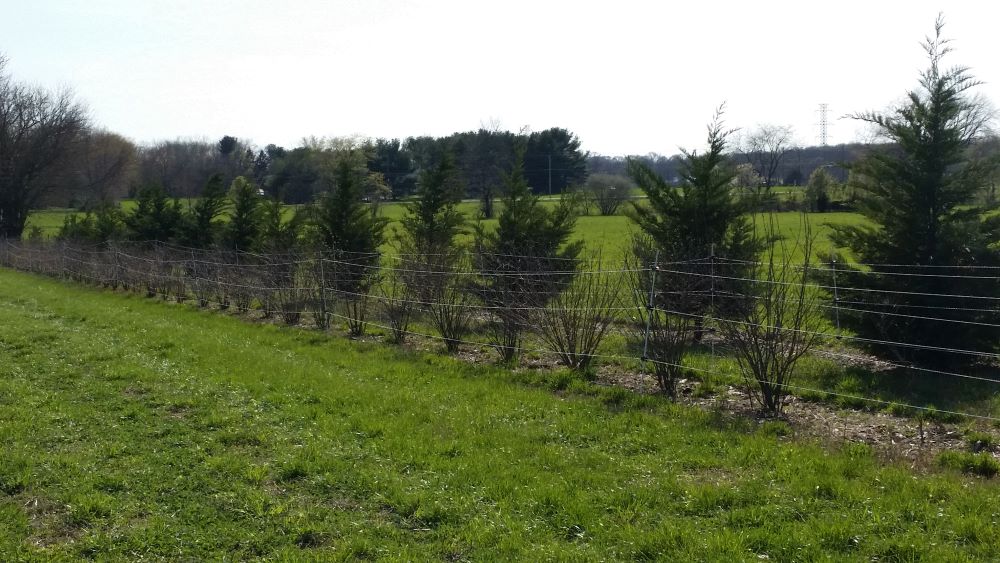Part 1 of 2
At Xerces, we rely upon the deep, place-based knowledge of our staff coupled with current research to guide our efforts to restore ecological function to areas that have been weakened by decades of extractive land use. We are constantly reviewing and incorporating new research to improve our restoration practices. These deep dives into research also end up in our guidance documents and scientific reports, such as How Neonicotinoids Can Kill Bees, Fungicide Impacts on Pollinators, and Drifting Toward Disaster.
Most recently, we have been wrestling with questions about the costs and benefits to pollinators of installing habitat in areas that are likely to be occasionally or continuously exposed to pesticides. What risks does pesticide contamination in field margins pose to pollinators, and how can we minimize pesticide exposure to maximize the benefits of habitat in working lands for pollinators? While the increasing evidence of insect declines creates urgency for our work to rewild landscapes, we do not want to install flowering habitat that crosses the line into an “ecological trap,” an area that attracts pollinators but ultimately has a negative impact on their survival and reproduction.
In this two-part blog, we’ll first dive into recent field studies on pesticide contamination of pollinator food and shelter in agricultural landscapes. This type of applied research helps to inform our conservation efforts. In next week’s blog, we’ll discuss how we apply this research in Xerces programs to create healthy, high-value habitat on the ground.

The evergreen windbreak on this organic farm helps to protect the newly installed pollinator hedgerow from pesticide drift from neighboring properties. (Photo: Kelly Gill, Xerces Society.)
From the literature: Key risks to pollinators in agricultural landscapes
Field margins and other habitat near treated crops are commonly contaminated with a mixture of pesticides, both in plants and soil.
Pesticides rarely stay where they are applied, and can find their way into nearby habitat via spray drift, dust off from the planting of pesticide-coated seeds, and movement with water or sediment – including moving sideways with water below the soil surface. Systemic insecticides can be taken up by plants in field margins and can reach the leaves, pollen, and nectar of flowering plants. Field studies that measured pesticide residues in field margins of canola and wheat crops, milkweeds and bee-collected pollen in corn and soybean landscapes, soils in and next to corn and soybean fields, cover crops in citrus orchards, as well as field borders and milkweeds in the densely agricultural Central Valley of California have found widespread contamination with a variable mixture of agrochemicals. Mixtures of insecticides, fungicides, herbicides, and miticides in agricultural landscapes may contribute substantially to the realized impacts of pesticide exposure on pollinators, as co-occurring chemicals can interact to increase toxicity to exposed insects.
Foliar (spray) applications of highly toxic insecticides are one of the top risks to pollinator habitat near crop fields.
A recent study in Minnesota soybeans found that aerial applications of chlorpyrifos, an insecticide with high toxicity to bees and other beneficial insects, resulted in residues exceeding lethal doses for honey bees more than 80 feet into adjacent tallgrass prairie (Goebel et al. 2022). Foliar applications pose particular risk if they overlap with active periods of vulnerable species or vulnerable life stages of bees, butterflies, and other beneficial insects. Specialist insect species with limited range and habitat requirements, such as specific host plants or vegetation preferences for perching, basking, and overwintering, are likely to be most at risk from local management practices like pesticide use and habitat disturbance.
Pesticide residues in field margin soils may negatively affect native bees.
Contaminated plants are not the only risk to pollinators in field margins – about two thirds of bee species nest below ground and can be exposed to pesticides in the soil as they dig out and build their underground nests. A recent study in Missouri row crops found neonicotinoids in 100% of soils from fields planted with neonic-treated seeds, over 90% of soil samples from the margins of treated fields, and half of soils next to other crops in this landscape. Fewer types of native bees were found in the margins of crop fields with neonicotinoid-contaminated soils than in the margins of fields where these insecticides were not found in the soil.
Catchment strips designed to capture sediment and nutrient runoff may be more universally contaminated with pesticides than other types of habitat near treated fields.
A recent study from Iowa State found that 80% of sampled vegetation in buffer strips sown with flowering plants (“prairie strips”) had detectable levels of neonicotinoid insecticides, including 80% of sampled milkweeds. This is a higher proportion of pesticide detections in vegetation (more universal contamination in the plants) than other studies with similar analytical methods that measured pesticide residues near agricultural fields, suggesting that habitat designed for the capture of field runoff is more likely to be contaminated than other near-field habitats.
Plus, two strategies to support pollinators in working lands
Reducing use of insecticide seed treatments would have important benefits for pollinator habitat in row crop landscapes.
A study in corn and soybean fields that had not received insecticide applications in the prior two years – including treated seeds – did not detect neonicotinoid insecticides in flowering plants in catchment habitat, suggesting that switching to untreated row crop seeds is an effective measure for protecting nearby habitat from contamination related to seed treatments.
Field margin flower plantings with abundant flowering resources can help to support bee populations in working lands.
A recent study in the Sacramento Valley of California found that flower plantings in marginal areas near crop fields supported greater nesting by mason bees (Osmia lignaria) and higher queen production by bumble bees (Bombus vosnesenskii) than similar sites without added floral resources. The study found that bumble bee queen production decreased significantly with pesticide risk (as measured from pesticide residues in bee-collected pollen loads), but that abundant local flowering resources helped to sustain some queen production at sites with high pesticide risk.

Recent research from UC Davis found that the abundant local flowering resources provided by field margin wildflower plantings helped to sustain bumble bee queen production even at sites with higher pesticide risk - Olam Orchards_CA_Pollinator Habitat. (Photo: Jessa Cruz/ Xerces Society.)
Four takeaways on agricultural pesticide risk to pollinators
Looking at these and many other studies leaves us with four takeaways:
- Pesticide use on crops can contaminate adjacent lands, sometimes at levels known to cause harm to bees and other beneficial insects.
- Pollinator habitat, even in agricultural landscapes where pesticide use is heavy, can support pollinators and add value. Insects cannot live without food and shelter.
- Pesticide contamination is likely to reduce the quality and value of habitat for pollinators. And,
- Many areas of uncertainty remain, making it difficult to fully assess the risks of pesticide contamination in flowering habitat to pollinator health and fitness.
More research is needed to better understand the complex pesticide mixtures and real-world concentrations that bees and other invertebrates are exposed to in air, plants, soil, and water – and, more fundamentally, how nutritional stress and pesticide exposure affect the ability of different pollinator species to survive and reproduce. We continue to monitor emerging research to refine our understanding of the issues and our conservation strategies. In the face of uncertainty, however, we take a precautionary approach to pesticide risk, and prioritize our limited resources on projects that create the highest quality habitat possible for pollinators.
Stay tuned for next week’s blog on this topic, in which we discuss how Xerces turns science into action in our conservation work. We help working lands come alive with the buzzing of insects by promoting ecologically sound pest management practices, advocating for systems-level change to reduce pesticide risks, and designing our habitat projects to avoid contamination.
References:
Botías, C., A. David, E. M. Hill, and D. Goulson. 2016. Contamination of wild plants near neonicotinoid seed-treated crops, and implications for non-target insects. Science of the Total Environment 566-567:269–278.
David, A., C. Botías, A. Abdul-Sada, E. Nicholls, E. L. Rotheray, E. M. Hill, and D. Goulson. 2016. Widespread contamination of wildflower and bee-collected pollen with complex mixtures of neonicotinoids and fungicides commonly applied to crops. Environment International 88:169–178.
García-Valcárcel, A. I., J. M. Campos-Rivela, M. D. Hernando Guil, and M. T. Martínez-Ferrer. 2022. Neonicotinoid contamination in wildflowers collected from citrus orchards in a northwestern Mediterranean Region (Spain) after tree foliar treatments. Environ Sci Pollut Res. https://doi.org/10.1007/s11356-022-19331-7.
Goebel, K. M., N. M. Davros, D. E. Andersen, and P. J. Rice. 2022. Tallgrass prairie wildlife exposure to spray drift from commonly used soybean insecticides in Midwestern USA. Science of the Total Environment 818:151745.
Hall, M. J., G. Zhang, M. E. O’Neal, S. P. Bradbury, and J. R. Coats. 2022. Quantifying neonicotinoid insecticide residues in milkweed and other forbs sampled from prairie strips established in maize and soybean fields. Agriculture, Ecosystems & Environment 325:107723.
Hladik, M. L., S. Bradbury, L. A. Schulte, M. Helmers, C. Witte, D. W. Kolpin, J. D. Garrett, and M. Harris. 2017. Neonicotinoid insecticide removal by prairie strips in row-cropped watersheds with historical seed coating use. Agriculture, Ecosystems & Environment 241:160–167.
Krupke, C. H., J. D. Holland, E. Y. Long, and B. D. Eitzer. 2017. Planting of neonicotinoid‐treated maize poses risks for honey bees and other non‐target organisms over a wide area without consistent crop yield benefit. Journal of Applied Ecology 54:1449–1458.
Long, E. Y., and C. H. Krupke. 2016. Non-cultivated plants present a season-long route of pesticide exposure for honey bees. Nature Communications 7:1–12.
Main, A. R., E. B. Webb, K. W. Goyne, R. Abney, and D. Mengel. 2021. Impacts of neonicotinoid seed treatments on the wild bee community in agricultural field margins. Science of the Total Environment 786:147299.
Main, A. R., E. B. Webb, K. W. Goyne, and D. Mengel. 2020. Reduced species richness of native bees in field margins associated with neonicotinoid concentrations in non-target soils. Agriculture, Ecosystems & Environment 287:106693.
Olaya-Arenas, P., and I. Kaplan. 2019. Quantifying pesticide exposure risk for monarch caterpillars on milkweeds bordering agricultural land. Frontiers in Ecology and Evolution 7:223.
Rundlöf, M., C. Stuligross, A. Lindh, R. L. Malfi, K. Burns, J. M. Mola, S. Cibotti, and N. M. Williams. 2022. Flower plantings support wild bee reproduction and may also mitigate pesticide exposure effects. The Journal of applied ecology.
Ward, L. T., M. L. Hladik, A. Guzman, S. Winsemius, A. Bautista, C. Kremen, and N. J. Mills. 2022. Pesticide exposure of wild bees and honey bees foraging from field border flowers in intensively managed agriculture areas. Science of the Total Environment 154697.




